Spain Mobile Payment Market Size
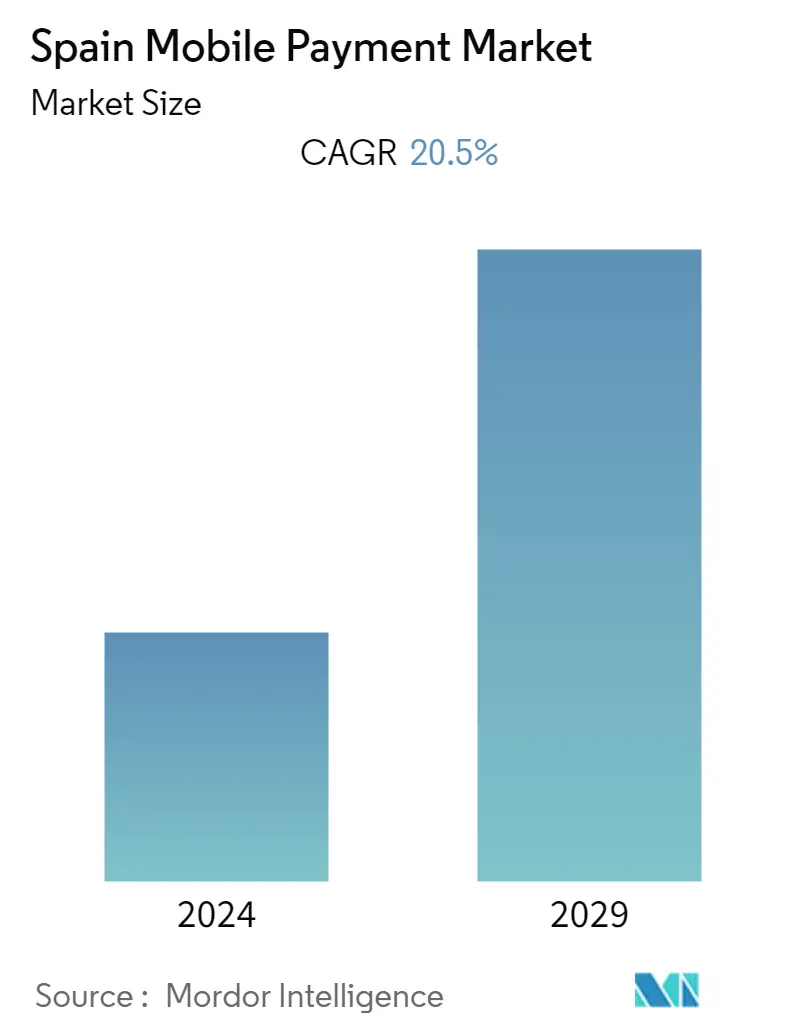
| Study Period | 2019 - 2029 |
| Base Year For Estimation | 2023 |
| Forecast Data Period | 2024 - 2029 |
| Historical Data Period | 2019 - 2022 |
| CAGR | 20.50 % |
| Market Concentration | Medium |
Major Players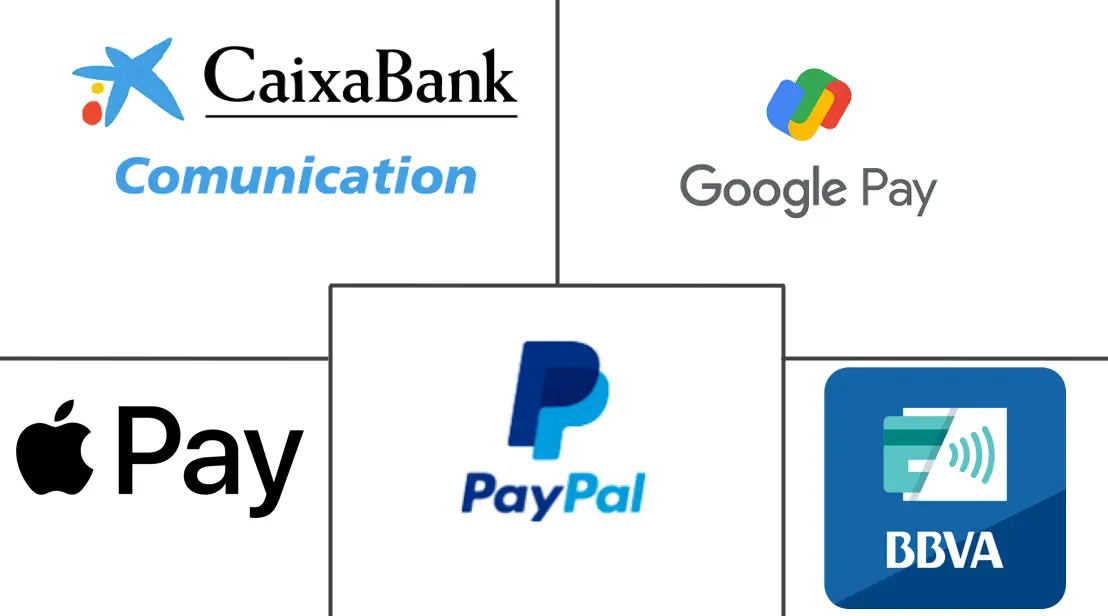
*Disclaimer: Major Players sorted in no particular order |
Spain Mobile Payment Market Analysis
Spain's mobile payments market is estimated to register a CAGR of 20.5 % from 2022 to 2027. The stores and services in Spain are rapidly adopting mobile payment applications, such as PayPal, Samsung Pay, Apple Pay, and other mobile payment offering companies to accept and transfer prices. With increasing internet penetration and rapid growth in online retailing, this trend is expected to continue over the forecast period. Spain's economy and technological advancements attract more investors to the growing mobile payments sector.
- The payment processing environment in Spain has grown significantly in recent times. Because of the rising need for contactless payments, the usage of digital payment methods instead of physical payments has spurred the growth of mobile payments.
- The introduction of Near Field Communication (NFC) in smartphones allowed smartphones and smart cards to be used. Users can make quick and safe payments on the move using smartphones' Tap to Pay features and apps. More and more banks are partnering with mobile payment service providers and coordinating the integration of their cards and internet banking alternatives to play an important role in enabling online transactions.
- The increased use of smartphones in the country has enabled the development and use of mobile applications for various purposes. With the introduction of payment applications and technologies such as mobile payments, customers are using the simple and smooth method to pay for online and in-store purchases, bill payments, money transfers, and many other things.
- However, data privacy remains a big challenge for mobile phone applications providing financial services. Companies are continuously attempting to create simpler and safer methods of authenticating their clients' identities, increasing their policies' safety and reliability.
- To prevent and control the growth of the Covid-19 epidemic, the need for contactless payments at retail stores such as grocery stores and restaurants has increased. Because there is no touch involved in the payment process, contactless payment solutions provided by mobile wallets are a secure alternative to handling cash and traditional credit cards.
Spain Mobile Payment Market Trends
This section covers the major market trends shaping the Spain Mobile Payment Market according to our research experts:
Increase in Number of Mobile Users and Internet Pentration Drive the Mobile Payment Market
- The growing mobile and internet penetration will likely boost the m-commerce payment sector. M-commerce payment refers to using wireless portable devices such as mobile phones and tablets to undertake commercial transactions such as product purchases and sales, online banking, and bill payment. As internet availability and penetration increase, more consumers may use m-commerce services.
- According to a survey conducted by Spanish fintech Pecunpay in February 2021, the payment methods in Spain are undergoing significant change. Even before the epidemic, digital payment methods have increased. The usage of mobile payments was increasing among Spaniards. For instance, 34 percent of the 2000 respondents polled in this survey said they made payments via phone. Furthermore, mobile payments are the third most popular payment method (12 Percent), after only cards (60 percent) and cash payments (22 percent ).
- Spain's mobile payments scenario is driven by the country's increasing network and internet infrastructure. Mobile payments are becoming more popular in the country's stores and services due to improved cellular and internet access.
- According to a survey conducted by Eurostat, Spain's share of daily internet users increased by three percent since the previous year. While the growth is slowing down, with 86 percent, the percentage of daily internet users is at its peak in the observed period. Notably, the share of daily internet users continuously increased over the last years.
- Although mobile payment solutions increase operational capability, reliability, and flexibility, most end users still rely entirely on cash for day-to-day operations. People have been using traditional payment methods for years and are not relay to adopt new technologies. Customers are more comfortable with conventional payment methods because of their habits when the transaction amount is significant. Furthermore, the payment method stores personal information such as location, balance, transaction history, card PIN, and other features. This increases the risk of the unauthorized use of personal data and raises consumer security concerns, thereby impeding business growth.
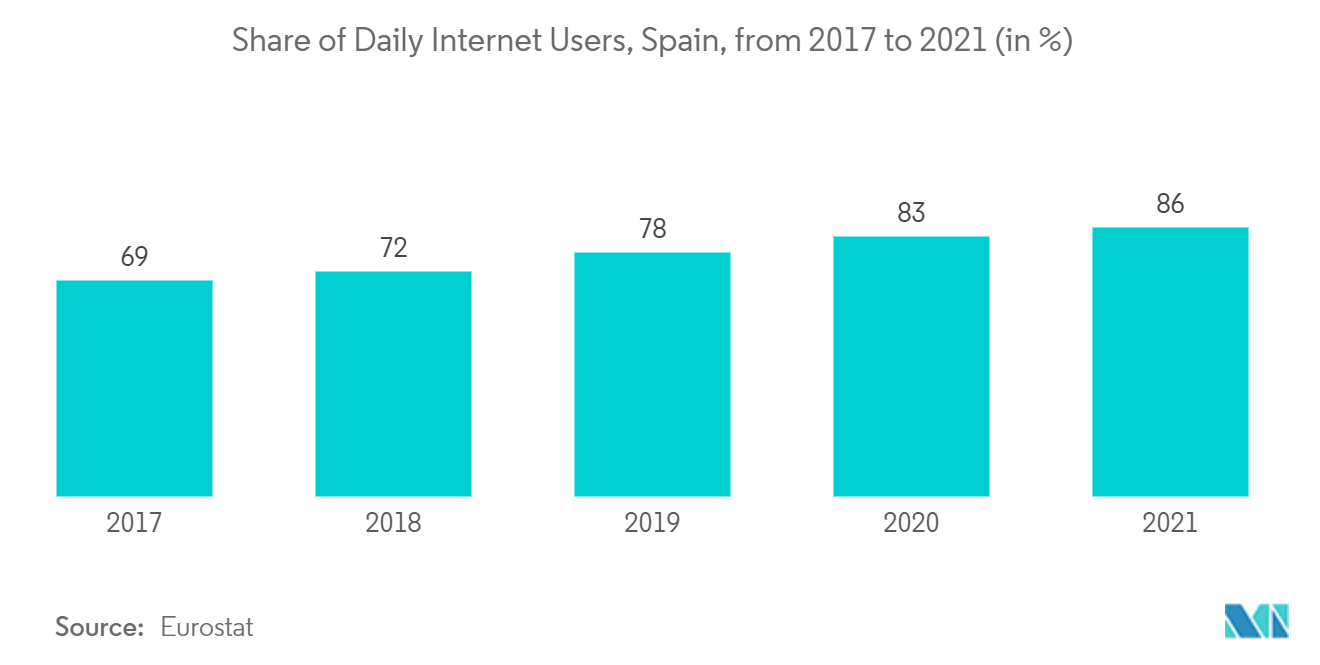
Significant Growth in Mobile Payments is Expected Due to Technological Advancement
- Mobile payments offer easy and secure methods to execute transactions. Individuals can use tokenization to keep credit and debit card information on their devices via mobile wallets. This changes card numbers, rendering the information worthless to hackers.
- However, due to the widespread COVID-19, the adoption of mobile payments has accelerated. With many users staying at home owing to the country's various lockdowns, the use of mobile payments in retail and e-commerce has grown.
- With such an increase in mobile payment adoption, service providers actively invest in innovative technologies to secure and improve mobile payment performance. AI and ML, biometric authentication, and other technologies are being incorporated into mobile payment systems to enhance payment security.
- Because mobile payments create huge volumes of data daily, security is an important component of mobile payment technology. The integration of AI and ML into mobile payment technologies for fraud detection has recently risen. Banks are continuously examining data generated by Machine Learning to detect fraudulent activities.
- Furthermore, in recent years, many banking service providers have incorporated biometric authorization technologies, such as fingerprint, iris, retina, vein, and other scanning forms. Furthermore, as more clients migrate to mobile payments, financial institutions are obliged to provide safe authentication methods, resulting in developments in biometric technology for authorization.
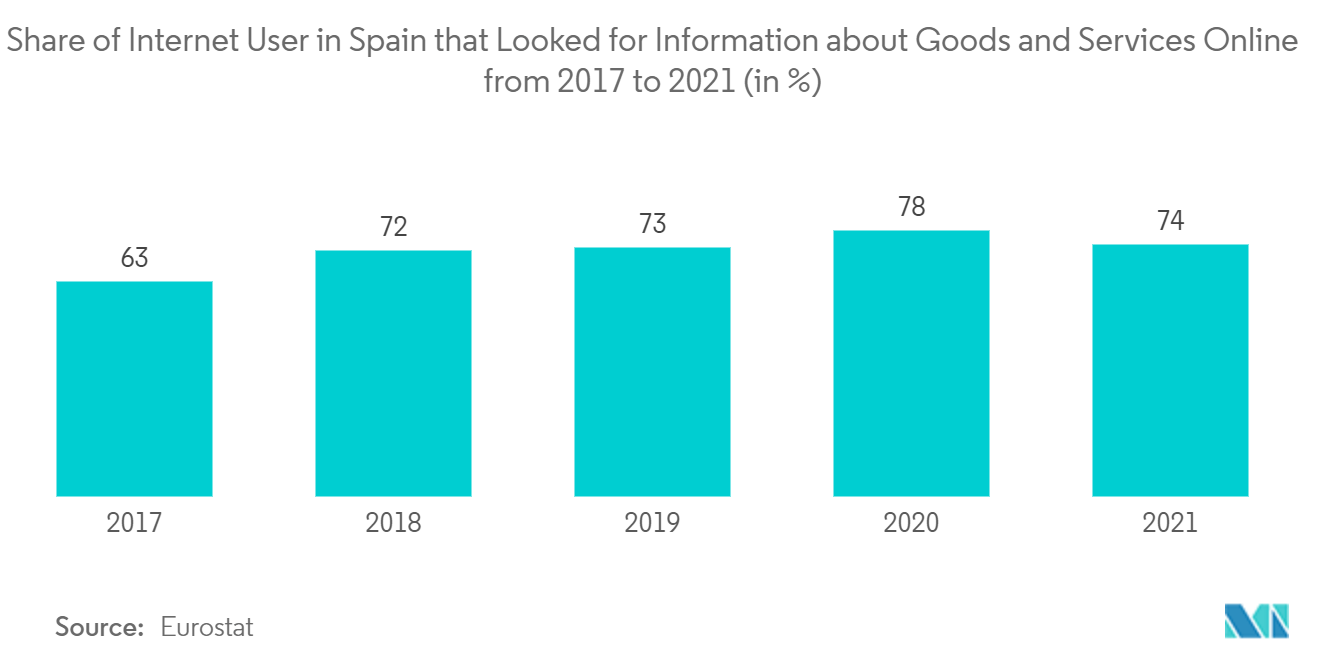
Spain Mobile Payment Industry Overview
The Spain mobile payments market is moderately fragmented with the presence of significant market players such as PayPal, Apple Inc. (Apple Pay), Google LLC(Google Pay), CaixaBank, SA(CaixaBank Pay), and PPRO(BBVA Wallet). The companies are introducing new offerings and continuously investing in partnerships, acquisitions, and mobile payment app developments to increase market share.
- May 2022 - Adyen, the global financial technology platform for top businesses, announced the expansion of its relationship with Afterpay Limited, one of the pioneers in Buy Now, Pay Later (BNPL). To support Adyen's worldwide expansion and momentum, Afterpay collaborates with the firm to process payments in major areas such as Australia, New Zealand, Canada, Europe, the United States, the United Kingdom, and Spain.
Spain Mobile Payment Market Leaders
-
Paypal
-
Apple Inc. (Apple Pay)
-
Google LLC (Google Pay)
-
CaixaBank, SA(CaixaBank Pay)
-
PPRO(BBVA Wallet)
*Disclaimer: Major Players sorted in no particular order
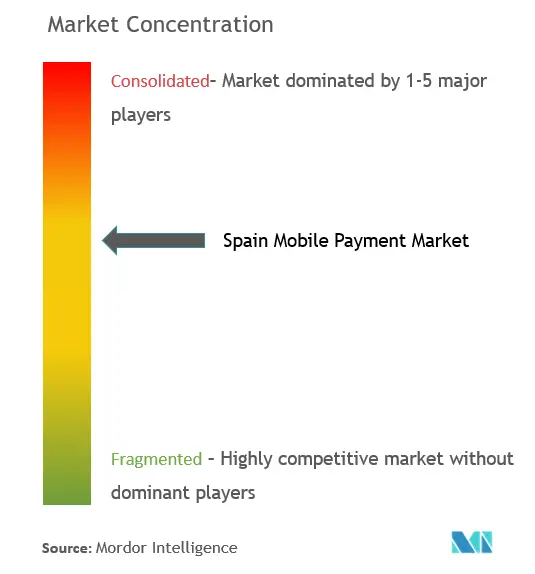
Spain Mobile Payment Market News
- June 2022 - CaixaBank, in collaboration with its payment method subsidiary along with Visa, and Swiss watch brand Swatch, launches Swatch Pay, which leads to increased customer mobile payments by 57 percent.
- February 2022 - GoDaddy provides a solution for small companies to expedite online and in-person payments by using QR codes for on-the-go transactions and producing a one-time QR code on the business owner's smartphone, which the consumer will be able to scan to complete the purchase. For further protection, the QR codes are personalized and expire after completing the transaction.
Spain Mobile Payment Market Report - Table of Contents
1. INTRODUCTION
- 1.1 Study Assumptions and Market Definitions
- 1.2 Scope of the Study
2. RESEARCH METHODOLOGY
3. EXECUTIVE SUMMARY
4. MARKET INSIGHT
- 4.1 Market Overview
- 4.2 Market Sizing and Estimates of Spain Mobile Payments Market
-
4.3 Industry Attractiveness-Porter's Five Force Analysis
- 4.3.1 Bargaining Power of Suppliers
- 4.3.2 Bargaining Power of Buyers
- 4.3.3 Threat of New Entrants
- 4.3.4 Threat of Substitute Products
- 4.3.5 Intensity of Competitive Rivalry
- 4.4 Assessment of COVID-19 Impact on the market
5. MARKET DYNAMICS
-
5.1 Market Drivers
- 5.1.1 Increase in Number of Mobile Users and Internet Pentration Drive the Mobile Payment Market
- 5.1.2 Significant Growth in Mobile Payments is Expected Due to Technological Advancement
-
5.2 Market Challenges
- 5.2.1 Security Issues Associated with Mobile Payments
-
5.3 Market Opportunities
- 5.3.1 Analysis on Enabling Technologies (Coverage to include NFC, QR, etc.)
- 5.3.2 Key Regulations and Standards in the Mobile Payments Industry
6. MARKET SEGMENTATION
-
6.1 BY TYPE (Market share in percentage based on relative adoption)
- 6.1.1 Proximity
- 6.1.2 Remote
7. Competitive Landscape
-
7.1 Company Profiles
- 7.1.1 PayPal
- 7.1.2 Apple Inc.(Apple Pay)
- 7.1.3 Google LLC(Google Pay)
- 7.1.4 CaixaBank, SA(CaixaBank Pay)
- 7.1.5 PPRO(BBVA Wallet)
- 7.1.6 SAMSUNG ELECTRONICS CO., LTD.(Samsung Pay)
- 7.1.7 Banco Santander-Chile(Santander Wallet)
- 7.1.8 Abanca Pay
- 7.1.9 Fitbit, Inc.(Fitbit Pay)
- 7.1.10 OrangePay
- 7.1.11 Bizum
- *List Not Exhaustive
8. Investment Analysis
9. Future Outlook of the Market
** Subject To AvailablitySpain Mobile Payment Industry Segmentation
Mobile payments automate payment systems by offering an alternative method of payment using a portable electronic device like a mobile or tablet. Mobile payments can also be used digitally for fund transfers rather than with a cheque or cash. Mobile payment technology provides diverse applications in end-user industries like movie tickets, food, and retail stores.
Spain Mobile Payment Market is Segmented By Type (Proximity and Remote).
| BY TYPE (Market share in percentage based on relative adoption) | Proximity |
| Remote |
Spain Mobile Payment Market Research FAQs
What is the current Spain Mobile Payment Market size?
The Spain Mobile Payment Market is projected to register a CAGR of 20.5% during the forecast period (2024-2029)
Who are the key players in Spain Mobile Payment Market?
Paypal, Apple Inc. (Apple Pay), Google LLC (Google Pay), CaixaBank, SA(CaixaBank Pay) and PPRO(BBVA Wallet) are the major companies operating in the Spain Mobile Payment Market.
What years does this Spain Mobile Payment Market cover?
The report covers the Spain Mobile Payment Market historical market size for years: 2019, 2020, 2021, 2022 and 2023. The report also forecasts the Spain Mobile Payment Market size for years: 2024, 2025, 2026, 2027, 2028 and 2029.
Spain Mobile Payment Industry Report
Statistics for the 2024 Spain Mobile Payment market share, size and revenue growth rate, created by Mordor Intelligence™ Industry Reports. Spain Mobile Payment analysis includes a market forecast outlook to 2029 and historical overview. Get a sample of this industry analysis as a free report PDF download.



